The Coupling Coordination Degree and Its Driving Factors for Water–Energy–Food Resources in the Yellow River Irrigation Area of Shandong Province
Abstract
:1. Introduction
2. Research Area and Data Sources
2.1. Research Area
2.2. Data Sources
3. Method
3.1. Comprehensive Evaluation Method
3.1.1. Construction of the Index System
3.1.2. Calculation of the Weights
Subjective Weighting of the G1 Method
Objective Weighting via the Entropy Weighting Method
Comprehensive Weighting Based on Game Theory
3.1.3. TOPSIS Evaluation Method
3.2. Coupling Coordination Degree Model
3.3. Geographically Weighted Regression Model
4. Result Analysis
4.1. Comprehensive Evaluation Index Analysis
4.1.1. Index Weight Results
4.1.2. Analysis of the Comprehensive Development Level
4.2. Analysis of Changes in the Coupling Coordination Degree
4.3. Analysis of the Driving Factors of the Coupling Coordination Degree
5. Discussion
6. Conclusions
Author Contributions
Funding
Institutional Review Board Statement
Informed Consent Statement
Data Availability Statement
Conflicts of Interest
Abbreviations
| WEF | water–energy–food |
| TOPSIS | technique for order preference by similarity to ideal solution |
| GWR | geographically weighted regression |
| OLS | ordinary least squares |
| NDVI | normalized difference vegetation index |
| AHP | analytic hierarchy process |
| G1 | ordinal relationship analysis |
| AIC | Akaike information criterion |
| FAO | Food and Agriculture Organization of the United Nations |
| PSR | pressure–state–response |
References
- Liu, Y.; Wang, S.; Chen, B. Regional Water–Energy–Food Nexus in China Based on Multiregional Input–Output Analysis. Energy Procedia 2017, 142, 3108–3114. [Google Scholar] [CrossRef]
- Bazilian, M.; Rogner, H.; Howells, M.; Hermann, S.; Arent, D.; Gielen, D.; Steduto, P.; Mueller, A.; Komor, P.; Tol, R.S.J.; et al. Considering the Energy, Water and Food Nexus: Towards an Integrated Modelling Approach. Energy Policy 2011, 39, 7896–7906. [Google Scholar] [CrossRef]
- Yang, Y.C.E.; Ringler, C.; Brown, C.; Mondal, M.A.H. Modeling the Agricultural Water–Energy–Food Nexus in the Indus River Basin, Pakistan. J. Water Resour. Plan. Manag. 2016, 142, 04016062. [Google Scholar] [CrossRef]
- Jiang, Y. China’s Water Scarcity. J. Environ. Manag. 2009, 90, 3185–3196. [Google Scholar] [CrossRef] [PubMed]
- Zhang, X.; Vesselinov, V.V. Integrated Modeling Approach for Optimal Management of Water, Energy and Food Security Nexus. Adv. Water Resour. 2017, 101, 1–10. [Google Scholar] [CrossRef]
- Li, M.; Fu, Q.; Singh, V.P.; Ji, Y.; Liu, D.; Zhang, C.; Li, T. An Optimal Modelling Approach for Managing Agricultural Water-Energy-Food Nexus under Uncertainty. Sci. Total Environ. 2019, 651, 1416–1434. [Google Scholar] [CrossRef]
- Karabulut, A.; Egoh, B.N.; Lanzanova, D.; Grizzetti, B.; Bidoglio, G.; Pagliero, L.; Bouraoui, F.; Aloe, A.; Reynaud, A.; Maes, J.; et al. Mapping Water Provisioning Services to Support the Ecosystem–Water–Food–Energy Nexus in the Danube River Basin. Ecosyst. Serv. 2016, 17, 278–292. [Google Scholar] [CrossRef]
- Zhang, J.; Oosterveer, P.; Li, Y.; Greene, M. Bioenergy versus Soil Improvement: Policy Coherence and Implementation Gaps in Crop Residue-Based Bioenergy Development in China. Water 2022, 14, 3527. [Google Scholar] [CrossRef]
- Bellezoni, R.A.; Sharma, D.; Villela, A.A.; Pereira Junior, A.O. Water-Energy-Food Nexus of Sugarcane Ethanol Production in the State of Goiás, Brazil: An Analysis with Regional Input-Output Matrix. Biomass Bioenergy 2018, 115, 108–119. [Google Scholar] [CrossRef]
- Cherubini, F.; Ulgiati, S. Crop Residues as Raw Materials for Biorefinery Systems—A LCA Case Study. Appl. Energy 2010, 87, 47–57. [Google Scholar] [CrossRef]
- Mannan, M.; Al-Ansari, T.; Mackey, H.R.; Al-Ghamdi, S.G. Quantifying the Energy, Water and Food Nexus: A Review of the Latest Developments Based on Life-Cycle Assessment. J. Clean. Prod. 2018, 193, 300–314. [Google Scholar] [CrossRef]
- Mohammadpour, P.; Mahjabin, T.; Fernandez, J.; Grady, C. From National Indices to Regional Action—An Analysis of Food, Energy, Water Security in Ecuador, Bolivia, and Peru. Environ. Sci. Policy 2019, 101, 291–301. [Google Scholar] [CrossRef]
- Li, W.; Jiang, S.; Zhao, Y.; Li, H.; Zhu, Y.; He, G.; Xu, Y.; Shang, Y. A Copula-Based Security Risk Evaluation and Probability Calculation for Water-Energy-Food Nexus. Sci. Total Environ. 2023, 856, 159236. [Google Scholar] [CrossRef]
- Li, X.; Liu, C.; Wang, G.; Bao, Z.; Diao, Y.; Liu, J. Evaluating the Collaborative Security of Water–Energy–Food in China on the Basis of Symbiotic System Theory. Water 2021, 13, 1112. [Google Scholar] [CrossRef]
- Gu, D.; Guo, J.; Fan, Y.; Zuo, Q.; Yu, L. Evaluating Water-Energy-Food System of Yellow River Basin Based on Type-2 Fuzzy Sets and Pressure-State-Response Model. Agric. Water Manag. 2022, 267, 107607. [Google Scholar] [CrossRef]
- Peng, S.; Zheng, X.; Wang, Y.; Jiang, G. Study on Water-Energy-Food Collaborative Optimization for Yellow River Basin. Adv. Water Sci. 2017, 28, 681–690. [Google Scholar] [CrossRef]
- Hu, M.-C.; Fan, C.; Huang, T.; Wang, C.-F.; Chen, Y.-H. Urban Metabolic Analysis of a Food-Water-Energy System for Sustainable Resources Management. Int. J. Environ. Res. Public Health 2018, 16, 90. [Google Scholar] [CrossRef]
- Wang, H.; Hong, J.; Liu, G. Simulation Research on Different Policies of Regional Green Development under the Nexus of Water-Energy-Food. China Popul. Environ. 2019, 29, 74–84. [Google Scholar] [CrossRef]
- Deng, P.; Chen, J.; Chen, D.; Shi, H.; Bi, B.; Liu, Z.; Yin, Y.; Cao, X. The Evolutionary Characteristics Analysis of the Coupling and Coordination among Water, Energy and Food: Take Jiangsu Province as an Example. J. Water Resour. Water Eng. 2017, 28, 232–238. [Google Scholar] [CrossRef]
- Han, D.; Yu, D.; Cao, Q. Assessment on the Features of Coupling Interaction of the Food-Energy-Water Nexus in China. J. Clean. Prod. 2020, 249, 119379. [Google Scholar] [CrossRef]
- Qi, Y.; Farnoosh, A.; Lin, L.; Liu, H. Coupling Coordination Analysis of China’s Provincial Water-Energy-Food Nexus. Environ. Sci. Pollut. Res. 2022, 29, 23303–23313. [Google Scholar] [CrossRef] [PubMed]
- Huang, D.; Wen, F.; Li, G.; Wang, Y. Coupled Development of the Urban Water-Energy-Food Nexus: A Systematic Analysis of Two Megacities in China’s Beijing-Tianjin-Hebei Area. J. Clean. Prod. 2023, 419, 138051. [Google Scholar] [CrossRef]
- Chen, B.; Ouyang, Z.; Sun, Z.; Wu, L.; Li, F. Evaluation on the Potential of Improving Border Irrigation Performance through Border Dimensions Optimization: A Case Study on the Irrigation Districts along the Lower Yellow River. Irrig. Sci. 2013, 31, 715–728. [Google Scholar] [CrossRef]
- Zhang, Z.; Ma, H.; Li, Q.; Wang, X.; Feng, G. Agricultural Planting Structure Optimization and Agricultural Water Resources Optimal Allocation of Yellow River Irrigation Area in Shandong Province. Desalination Water Treat. 2014, 52, 2750–2756. [Google Scholar] [CrossRef]
- Liu, L.; Ma, J.; Hao, X.; Li, Q. Limitations of Water Resources to Crop Water Requirement in the Irrigation Districts along the Lower Reach of the Yellow River in China. Sustainability 2019, 11, 4680. [Google Scholar] [CrossRef]
- Wang, W.; Song, X.; Ma, Y. Identification of Nitrate Source Using Isotopic and Geochemical Data in the Lower Reaches of the Yellow River Irrigation District (China). Environ. Earth Sci. 2016, 75, 936. [Google Scholar] [CrossRef]
- Liu, C.; Jiang, E.; Liu, S.; Qu, B.; Chang, B. Agricultural Water and Land Resources Utilization Efficiency Based on Green Production and Resources Synergy. Trans. Chin. Soc. Agric. Mach. 2022, 53, 369–378. [Google Scholar] [CrossRef]
- Liu, C.; Zhang, Z.; Liu, S.; Liu, Q.; Feng, B.; Tanzer, J. Evaluating Agricultural Sustainability Based on the Water–Energy–Food Nexus in the Chenmengquan Irrigation District of China. Sustainability 2019, 11, 5350. [Google Scholar] [CrossRef]
- Dong, L.; Lihui, Z.; Heng, L.; Qiang, F.; Mo, L.; Faiz, M.A.; Ali, S.; Tianxiao, L.; Khan, M.I. Optimization of Irrigation Water Use Efficiency Evaluation Indicators Based on DPSIR-ISD Model. Water Supply 2020, 20, 83–94. [Google Scholar] [CrossRef]
- Li, M.; Fu, Q.; Singh, V.P.; Liu, D.; Li, T. Stochastic Multi-Objective Modeling for Optimization of Water-Food-Energy Nexus of Irrigated Agriculture. Adv. Water Resour. 2019, 127, 209–224. [Google Scholar] [CrossRef]
- Wang, J.; Zhou, H.; Tso, G.K.F.; Po Hsun, C.; Tua, C.; Zheng, T. Integrated Safety Assessment of Water–Energy–Food Systems Based on Improved Substance Element Extensions. J. Water Clim. Change 2023, 14, 4617–4634. [Google Scholar] [CrossRef]
- Fan, X.; Qin, J.; Lv, M.; Jiang, M. An Evaluation System of the Modernization Level of Irrigation Districts with an Analysis of Obstacle Factors: A Case Study for North China. Agronomy 2024, 14, 538. [Google Scholar] [CrossRef]
- Qian, C.; Zhang, M.; Yinting, Y.; Wang, R. A Quantitative Judgement Method for Safety Admittance of Facilities in Chemical Industrial Parks Based on G1-Variation Coefficient Method. Procedia Eng. 2014, 84, 223–232. [Google Scholar] [CrossRef]
- Mansour, F.; Al-Hindi, M.; Yassine, A.; Najjar, E. Multi-Criteria Approach for the Selection of Water, Energy, Food Nexus Assessment Tools and a Case Study Application. J. Environ. Manag. 2022, 322, 116139. [Google Scholar] [CrossRef]
- Xia, Q.; Tian, G.; Zhao, D.; Zhao, Q.; Varis, O. Effects of New-Type Urbanization on Resource Pressure: Evidence from a Water-Energy-Food System Perspective in China. Sustain. Cities Soc. 2024, 107, 105411. [Google Scholar] [CrossRef]
- Cheng, Y.; Wang, J.; Shu, K. The Coupling and Coordination Assessment of Food-Water-Energy Systems in China Based on Sustainable Development Goals. Sustain. Prod. Consum. 2023, 35, 338–348. [Google Scholar] [CrossRef]
- Ju, K.; Wang, J.; Wei, X.; Li, H.; Xu, S. A Comprehensive Evaluation of the Security of the Water-Energy-Food Systems in China. Sustain. Prod. Consum. 2023, 39, 145–161. [Google Scholar] [CrossRef]
- Chen, W.; Chen, Y. Two-Step Measurement of Water–Energy–Food Symbiotic Coordination and Identification of Key Influencing Factors in the Yangtze River Basin. Entropy 2021, 23, 798. [Google Scholar] [CrossRef] [PubMed]
- Guo, L.; Wu, Y.; Huang, F.; Jing, P.; Huang, Y. An Approach to Complex Transboundary Water Management in Central Asia: Evolutionary Cooperation in Transboundary Basins under the Water-Energy-Food-Ecosystem Nexus. J. Environ. Manag. 2024, 351, 119940. [Google Scholar] [CrossRef]
- Zhu, Y.; Zhang, C.; Huang, D. Assessing Urban Water–Energy–Food Security: A Case of Yangtze River Delta Urban Agglomeration. Soc. Indic. Res. 2024, 24, 1–30. [Google Scholar] [CrossRef]
- Wang, S.; Yang, J.; Wang, A.; Liu, T.; Du, S.; Liang, S. Coordinated Analysis and Evaluation of Water–Energy–Food Coupling: A Case Study of the Yellow River Basin in Shandong Province, China. Ecol. Indic. 2023, 148, 110138. [Google Scholar] [CrossRef]
- Jing, P.; Hu, T.; Sheng, J.; Mahmoud, A.; Liu, Y.; Yang, D.; Guo, L.; Li, M.; Wu, Y. Coupling Coordination and Spatiotemporal Dynamic Evolution of the Water-Energy-Food-Land (WEFL) Nexus in the Yangtze River Economic Belt, China. Environ. Sci. Pollut. Res. 2022, 30, 34978–34995. [Google Scholar] [CrossRef] [PubMed]
- Wang, Y.; Song, J.; Sun, H. Coupling Interactions and Spatial Equilibrium Analysis of Water-Energy-Food in the Yellow River Basin, China. Sustain. Cities Soc. 2023, 88, 104293. [Google Scholar] [CrossRef]
- Wang, S.; Yang, R.; Shi, S.; Wang, A.; Liu, T.; Yang, J. Characteristics and Influencing Factors of the Spatial and Temporal Variability of the Coupled Water–Energy–Food Nexus in the Yellow River Basin in Henan Province. Sustainability 2023, 15, 13977. [Google Scholar] [CrossRef]
- Li, H.; Wang, H.; Yang, Y.; Zhao, R. Regional Coordination and Security of Water–Energy–Food Symbiosis in Northeastern China. Sustainability 2021, 13, 1326. [Google Scholar] [CrossRef]
- Sun, L.; Niu, D.; Yu, M.; Li, M.; Yang, X.; Ji, Z. Integrated Assessment of the Sustainable Water-Energy-Food Nexus in China: Case Studies on Multi-Regional Sustainability and Multi-Sectoral Synergy. J. Clean. Prod. 2022, 334, 130235. [Google Scholar] [CrossRef]
- Mondal, K.; Chatterjee, C.; Singh, R. Examining the Coupling and Coordination of Water-Energy-Food Nexus at a Sub-National Scale in India—Insights from the Perspective of Sustainable Development Goals. Sustain. Prod. Consum. 2023, 43, 140–154. [Google Scholar] [CrossRef]
- Koh, E.-H.; Lee, E.; Lee, K.-K. Application of Geographically Weighted Regression Models to Predict Spatial Characteristics of Nitrate Contamination: Implications for an Effective Groundwater Management Strategy. J. Environ. Manag. 2020, 268, 110646. [Google Scholar] [CrossRef]
- Wang, Y.; Wei, L.; Hou, Y. Study on the Coordination of Ecological Environmental Protection and High-Quality Economic Development in the Shandong Section of the Yellow River Basin. Rural. Sci. Technol. 2023, 14, 51–55. [Google Scholar] [CrossRef]
- Mostefaoui, L.; Sušnik, J.; Masia, S.; Jewitt, G. A Water–Energy–Food Nexus Analysis of the Impact of Desalination and Irrigated Agriculture Expansion in the Ain Temouchent Region, Algeria. Environ. Dev. Sustain. 2024, 10, 1–27. [Google Scholar] [CrossRef]
- Putra, M.P.I.F.; Pradhan, P.; Kropp, J.P. A Systematic Analysis of Water-Energy-Food Security Nexus: A South Asian Case Study. Sci. Total Environ. 2020, 728, 138451. [Google Scholar] [CrossRef] [PubMed]
- Botai, C.M.; Botai, J.O.; Tazvinga, H.; Murambadoro, M.; Nhamo, L.; Ncongwane, K.P.; Mengistu, M.G.; Zwane, N.; Wamiti, E.; Mpandeli, S.; et al. Assessment of Rural Livelihoods, Health and Wellbeing in Vhembe District Municipality, South Africa and Narok County, Kenya: A Water-Energy-Food Nexus Perspective. Environ. Sci. Policy 2024, 159, 103817. [Google Scholar] [CrossRef]
- Wang, H.; Huang, S.; Di, D.; Wang, Y.; Zhang, F. Study on the Spatial Distribution of Water Resource Value in the Agricultural System of the Yellow River Basin. Water Policy 2021, 23, 1044–1058. [Google Scholar] [CrossRef]
- Sun, Y.; Chen, X.; Luo, Y.; Cao, D.; Feng, H.; Zhang, X.; Yao, R. Agricultural Water Quality Assessment and Application in the Yellow River Delta. Agronomy 2023, 13, 1495. [Google Scholar] [CrossRef]
- Li, Y.; Huang, S.; Han, M. An Assessment of the Factors That Drive Changes in the Distribution and Area of Cultivated Land in the Yellow River Delta, China. Environ. Earth Sci. 2022, 81, 227. [Google Scholar] [CrossRef]
- Wang, L.; Zhu, Q.; Zhang, J.; Liu, J.; Zhu, C.; Qu, L. Vegetation Dynamics Alter the Hydrological Interconnections between Upper and Mid-Lower Reaches of the Yellow River Basin, China. Ecol. Indic. 2023, 148, 110083. [Google Scholar] [CrossRef]
- Madani, Z.; Natcher, D. Water, Energy and Food (WEF) Nexus in the Changing Arctic: An International Law Review and Analysis. Water 2024, 16, 835. [Google Scholar] [CrossRef]
- Oulu, M.; Darko, D.; Osaliya, R.; Aziz, F.; Wekesa, D. Governing the Nexus: Water-Energy-Food Nexus Governance Strategies in Ghana and Uganda. Environ. Dev. 2023, 48, 100933. [Google Scholar] [CrossRef]
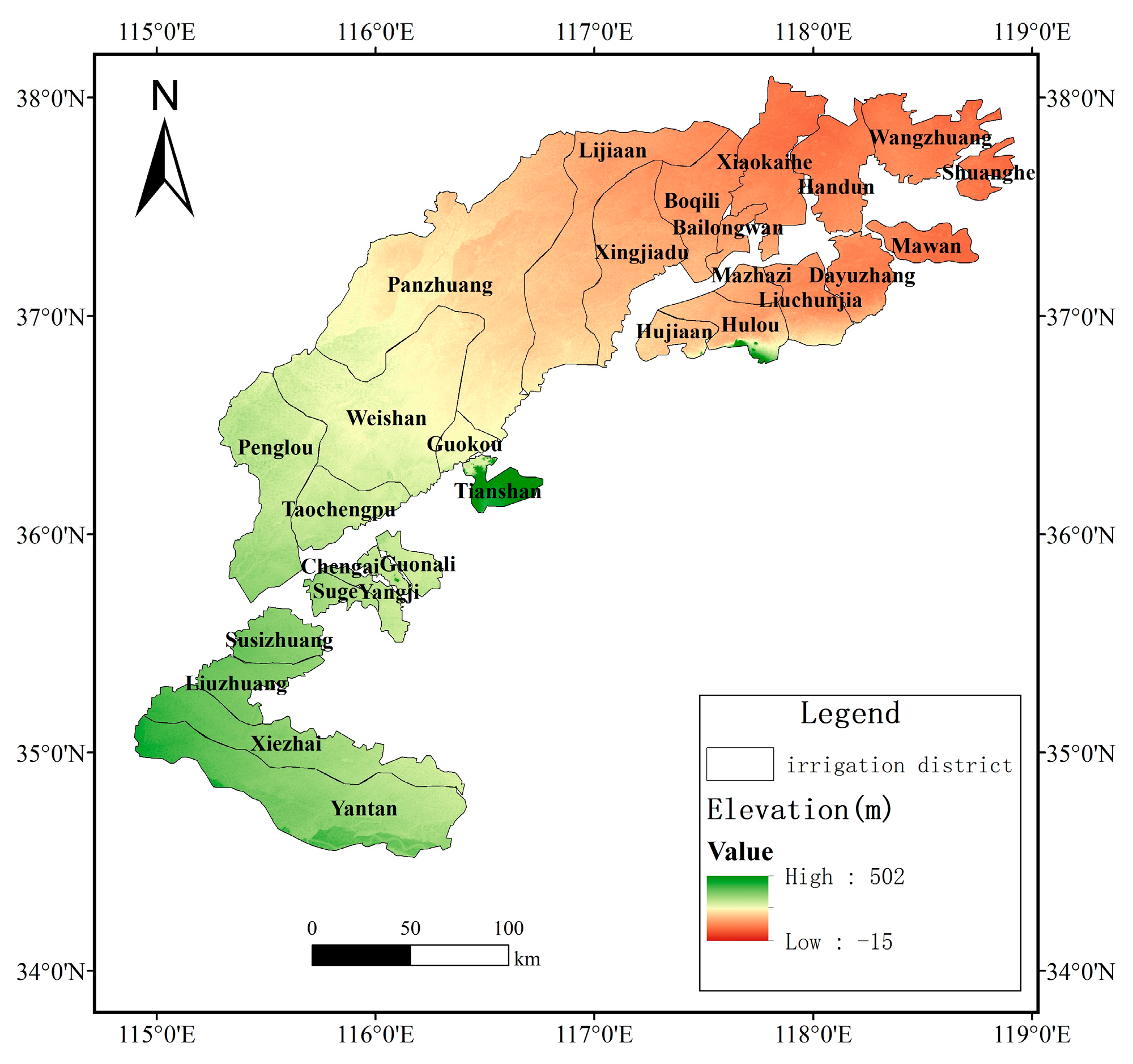

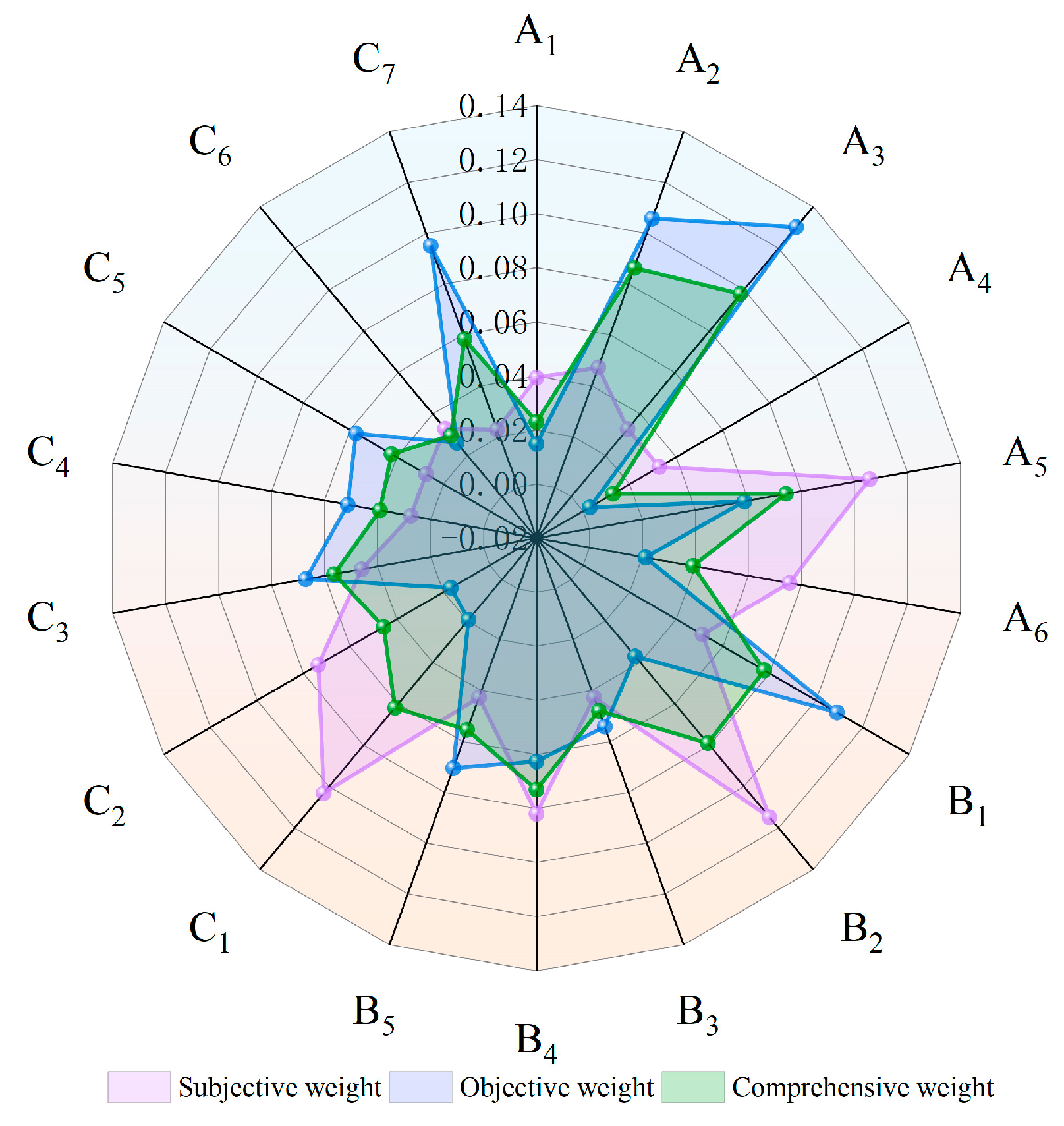
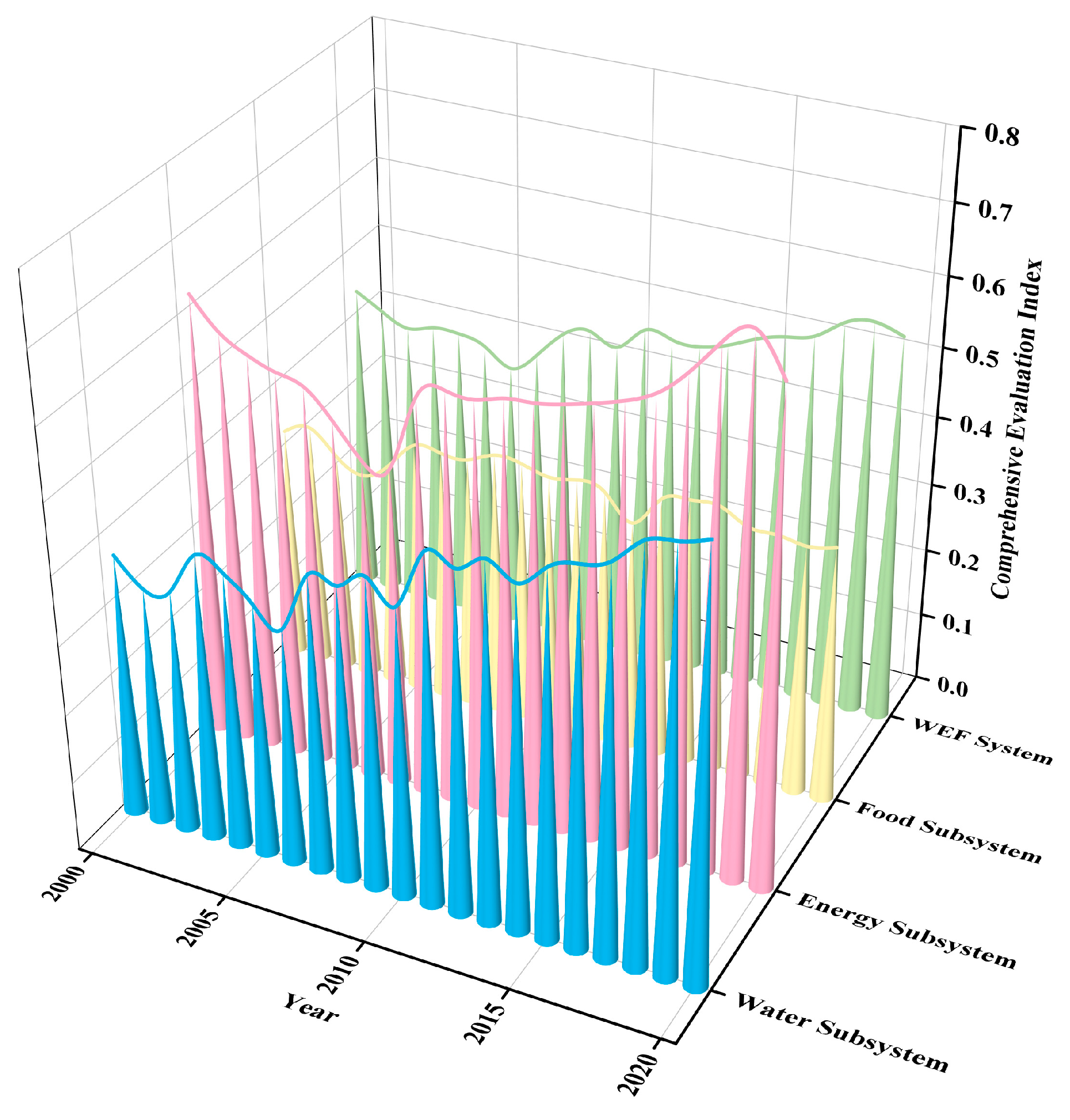
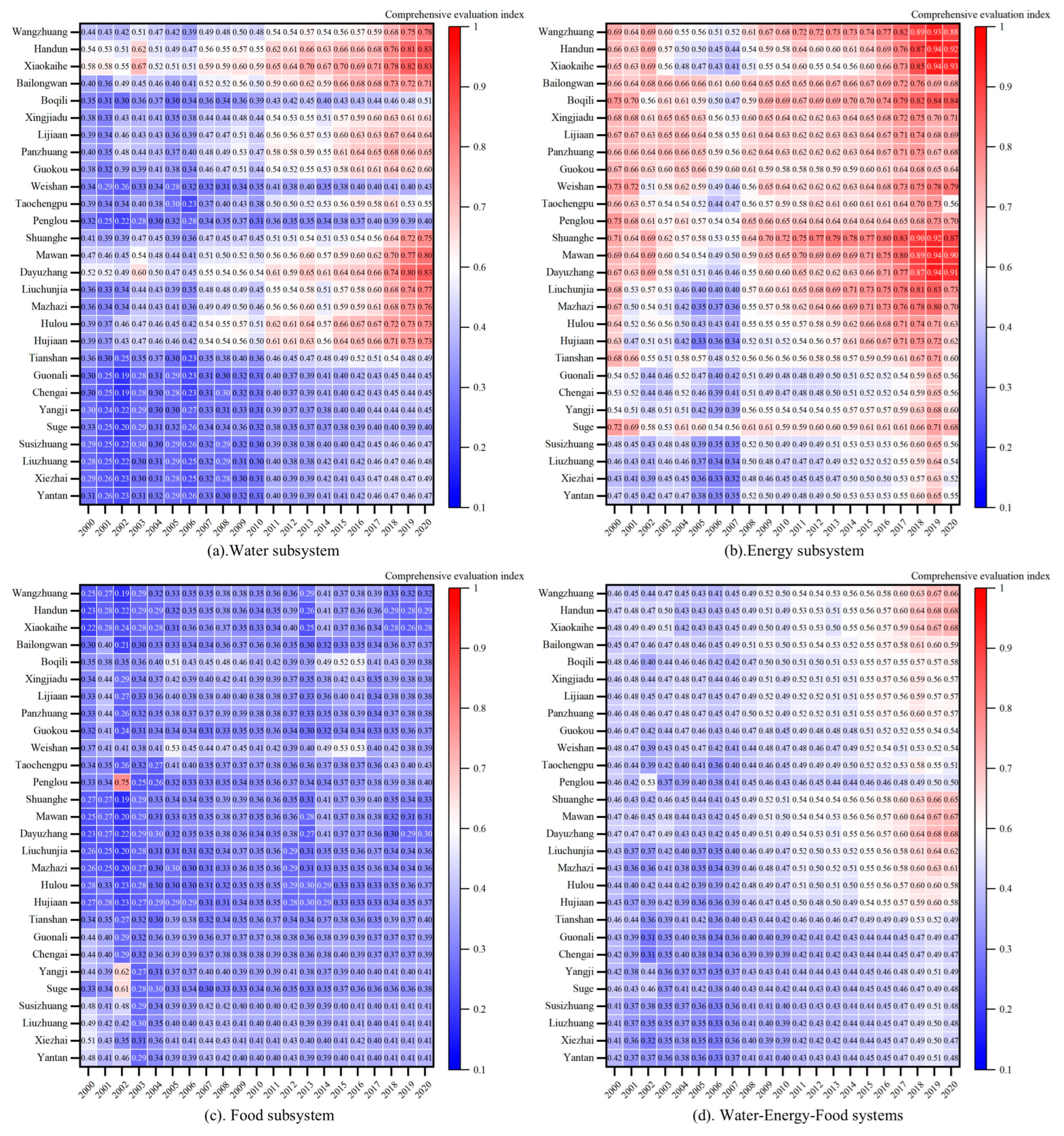

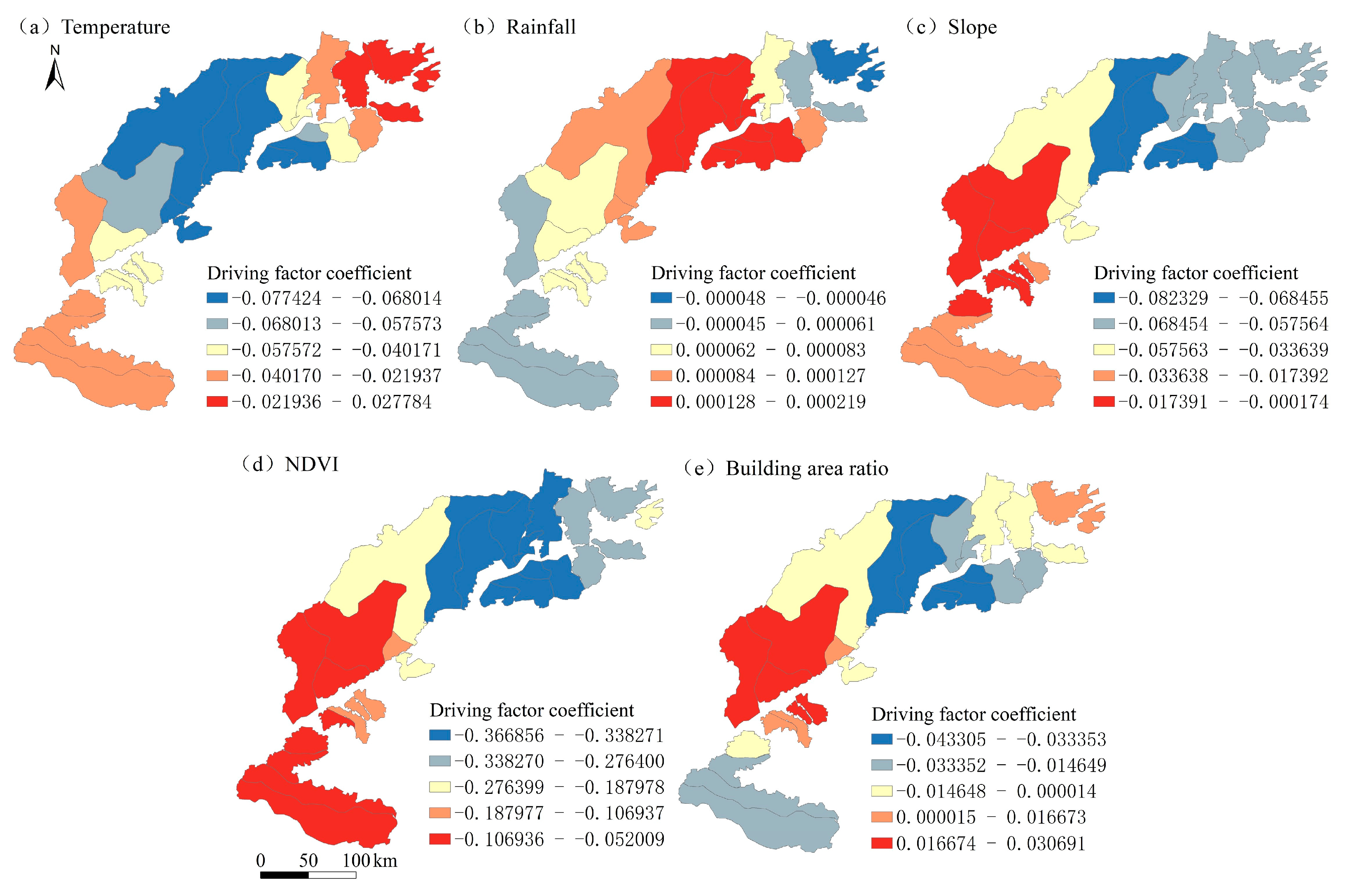
| Target Layer | Subsystem | Index Layer | Index Attribute | Number |
|---|---|---|---|---|
| Comprehensive evaluation index system for the WEF system | Water resource system | Water resource utilization rate | Negative | A1 |
| Groundwater supply ratio | Negative | A2 | ||
| Agricultural water use ratio | Negative | A3 | ||
| Effective irrigation area ratio | Positive | A4 | ||
| Blue water use per unit area | Negative | A5 | ||
| Effective rainfall | Positive | A6 | ||
| Energy system | Fertilizer use per unit area | Negative | B7 | |
| Electricity use per unit area | Negative | B8 | ||
| Plastic film use per unit area | Negative | B9 | ||
| Agricultural diesel use per unit area | Negative | B10 | ||
| Pesticide use per unit area | Negative | B11 | ||
| Food system | Wheat yield per unit area | Positive | C12 | |
| Corn yield per unit area | Positive | C13 | ||
| Rice yield per unit area | Positive | C14 | ||
| Bean yield per unit area | Positive | C15 | ||
| Potato yield per unit area | Positive | C16 | ||
| Cotton yield per unit area | Positive | C17 | ||
| Yield of other grains per unit area | Positive | C18 |
| ri | Meaning |
|---|---|
| 1.0 | Indices ci−1 and ci are equally important |
| 1.2 | Index ci−1 is slightly more important than index ci |
| 1.4 | Index ci−1 is clearly more important than index ci |
| 1.6 | Index ci−1 is much more important than index ci |
| 2.0 | Index ci−1 is extremely important compared with index ci |
| Development Stage | Coupling Coordination Degree | Grade Standards |
|---|---|---|
| Extreme disorder | [0, 0.1) | Extreme dysregulation and decline |
| [0.1, 0.2) | Severe dysregulation and decline | |
| Basic disorder | [0.2, 0.3) | Moderate dysregulation and decline |
| [0.3, 0.4] | Mild dysregulation and decline | |
| Transition coordination | [0.4, 0.5) | On the brink of dysregulation and decline |
| [0.5, 0.6) | Barely coordinated development | |
| Moderate coordination | [0.6, 0.7) | Primary coordinated development |
| [0.7, 0.8) | Intermediate coordinated development | |
| High coordination | [0.8, 0.9) | Well-coordinated development |
| [0.9, 1.0] | Highly coordinated development |
| Variable | Dimension | Driving Factor | Number |
|---|---|---|---|
| Independent variable | Natural factor | Temperature | X1 |
| Rainfall | X2 | ||
| Slope | X3 | ||
| NDVI | X4 | ||
| Social factor | Building area ratio | X5 | |
| Dependent variable | Coupling coordination degree | Y | |
| Model | AICc | R2 | Adjusted R2 |
|---|---|---|---|
| OLS | −137.4727 | 0.8298 | 0.7912 |
| GWR | −141.4521 | 0.9562 | 0.9462 |
Disclaimer/Publisher’s Note: The statements, opinions and data contained in all publications are solely those of the individual author(s) and contributor(s) and not of MDPI and/or the editor(s). MDPI and/or the editor(s) disclaim responsibility for any injury to people or property resulting from any ideas, methods, instructions or products referred to in the content. |
© 2024 by the authors. Licensee MDPI, Basel, Switzerland. This article is an open access article distributed under the terms and conditions of the Creative Commons Attribution (CC BY) license (https://creativecommons.org/licenses/by/4.0/).
Share and Cite
Zhang, W.; Liu, C.; Li, L.; Jiang, E.; Zhao, H. The Coupling Coordination Degree and Its Driving Factors for Water–Energy–Food Resources in the Yellow River Irrigation Area of Shandong Province. Sustainability 2024, 16, 8473. https://doi.org/10.3390/su16198473
Zhang W, Liu C, Li L, Jiang E, Zhao H. The Coupling Coordination Degree and Its Driving Factors for Water–Energy–Food Resources in the Yellow River Irrigation Area of Shandong Province. Sustainability. 2024; 16(19):8473. https://doi.org/10.3390/su16198473
Chicago/Turabian StyleZhang, Wei, Chang Liu, Lingqi Li, Enhui Jiang, and Hongjun Zhao. 2024. "The Coupling Coordination Degree and Its Driving Factors for Water–Energy–Food Resources in the Yellow River Irrigation Area of Shandong Province" Sustainability 16, no. 19: 8473. https://doi.org/10.3390/su16198473






